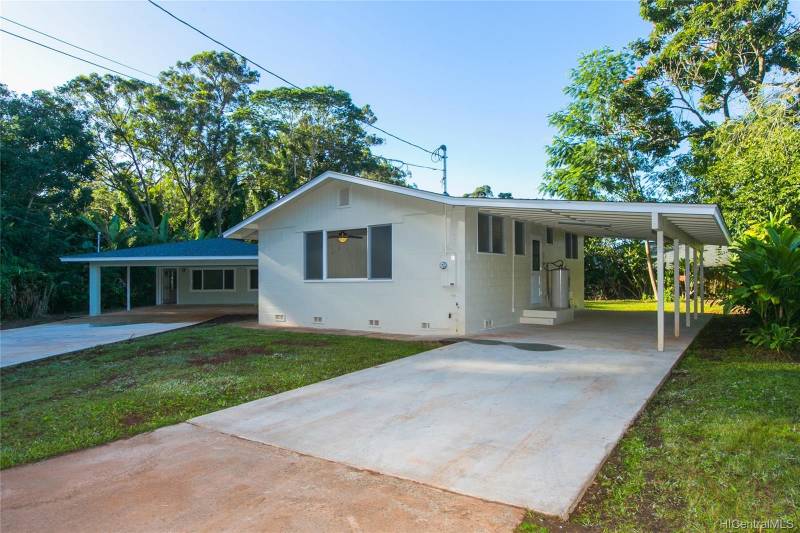
A CPR’d home with 2 entrances
CPR?
For a lot of Hawaii homebuyers, the home search begins online. They pull up a real estate website, plug in some criteria and are immediately shown hundreds of current listings. When looking at different property types the head scratching begins, “Why is this single family home listed as a ‘CPR property,’ and what exactly does that mean?
‘Condominium’ By Definition
To understanding Condominium Property Regimes (CPR properties), it’s important to know and understand what a ‘condominium’ is not. Contrary to popular belief, the term condo doesn’t describe the type of building (i.e. multiple residences in a multi-story structure). Condominium denotes the type of ownership. Condo homeowners do own their units/homes exclusively, but all members of the condo-project have ownership in the land and certain ‘common elements.’ Common elements are usually hallways, lobbies, roofs, and recreation areas. Limited common elements are for exclusive use of the owner and usually include things like parking spaces and yards.

Currently Listed: Wahiawa CPR property with a roomy yard and private driveway. Click here for more information. https://www.hawaiilife.com/daniellecapozzi/listings/2127-california-avenue-d-wahiawa-hi-96786
Condominium Property Regimes
To “CPR a property”, is to condominiumize a property into two or more individual units for ownership purposes. In Hawaii, where land is expensive, it’s common that an owner decides to split/sell parts of their property or home. A CPR property can be a single-family home divided in two, or it can be unattached. Sometimes, it’s multiple condo units or structures on one parcel. Each unit is separate and has it’s own identifiable TMK number, deed, property taxes, mortgage, and basic housing expenses. These units are a piece of real property and can be sold or leased in the future.

Condo Laws and Restrictions
All condos, although separate units, share the same parcel and because of this, are governed by an association which represents the collective owners. It’s common to see condo associations with covenants and restrictions, which are usually put in place to protect the owners and to maintain the condo project. Some condo projects, like CPR’d single-family homes and properties may have nearly no restrictions or maintenance fees, while some larger condominium buildings will have a very detailed list of condo by-laws, restrictions and a maintenance fee.
Something to consider about condominiums, in general, is that although you can do whatever you’d like with your property and its interior, you may not be able to alter its footprint. Let’s say you had a 900 sqft CPR’d home. Would you be able to redo the bathroom, paint the garage, and open up the living room by removing a wall? Yes. But will you be able to build another story, extend the building’s square footage, or anything that drastically alters the unit’s footprint? Maybe, but it depends on the CPR.
One more thing to remember: a condo association’s rules and restrictions can be more restrictive than the city and county. For example, if the city says you can do 30-day rentals and the association says 6 months minimum, the rules of the association trump the city and county. This can be an advantageous restriction for homeowners who want to be sure that their neighbors aren’t running an illegal rental.

One of 5 homes on a spacious Wahiawa parcel. Available for purchase individually, or the entire property with multiple units.
Opportunity Knocks
CPR properties bring opportunity to homeowners in Hawaii. For buyers, the opportunity to buy and own a single-family home for less than a traditional single-family sale, which requires buying the entire property. Also, buyers with pets may find that CPRs offer an affordable opportunity to buy a pet-friendly home with a yard. For those who decide to develop a CPR, it gives them the opportunity to cash in by selling part of the land or home.
Hawaii has some of the most progressive condominium laws in the country. For further reading, see the Condominium Property Act, Chapter 514A, Hawaii Revised Statutes.
I highly recommend when thinking about buying a CPR that buyers read closely through the condominium documents. You want to know things like the condo/building’s reserve numbers; how much money does the building have for deferred maintenance, end of life upgrades, and general repairs? You want a well-funded building. Find out how the condo association handles the maintenance of common elements and if there are any upcoming repairs or current/future special assessments. It’s also helpful to know of any issues or disputes between current owners. Be sure to look closely at the covenants and restrictions, by-laws, CPR declaration, and house-rules. A good real estate agent will be able to get that information for you and guide you through the process.
If you’ve got questions, I’m happy to help.




Michael Sindell
December 25, 2019
Ben,
Thank you for your article on CPR properties. I found it very insightful. I am looking at a property in upcountry Maui that is designated as agriculture zoning. The house is an older home and sits on a couple acres. The owner built a new larger home and designated the remainder of the property as part of the CPR for the larger home (several acres).
My question is can I add on to the original home that sits on a couple acres ? It’s approx 1,300 SF but I would like to eventually add another story. I was told that because the two homes share one water meter that neither home can add another bathroom ie the water fixtures are at the maximum allowable number.
However I’m still interested in adding a room and/or another story. How do I find out whether or not this is permissible?
Thank in advance.